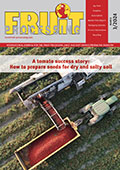The outlook for consumption of fresh fruit and vegetables remains under pressure in the European Union. These are the conclusions from the latest consumption trends discussed in Freshfel Europe through a review of trends in Member States, covering 75 % of the EU population. Despite a very positive momentum for consumption growth, many barriers are severely impacting the move towards a healthier and more sustainable diet for European consumers.
The latest findings from the Freshfel Europe Consumption Monitor reveal that the average consumption for fresh produce stands at an average of 364 g/capita/day for 2021, a figure that could decline by ca 10 % in 2022 once the final data for last year is known. This is particularly worrying at it stays well below the minimum 400 gr. recommendation of WHO. These figures are driven by the low level of consumption by millennials and the youngest generations, which are tomorrow’s consumers. Under the difficult economic conditions, the consumption among the low-income population is also of particular concern. Informing and engaging with consumers to choose healthy, affordable and sustainable diets was identified as a priority not only for Freshfel Europe but also for retailer organisation EuroCommerce and the consumer organisation BEUC who attended the meeting to share their perspectives.
The economic crisis impacting all Member States following the war in Ukraine and growing protectionism in the world is severely impacting consumer purchasing power and limiting their food expenditure. In times of crisis, these consumers tend to move towards a less healthy diet, which is perceived to be more energy satisfactory and a cheaper food option. Freshfel Europe General Delegate Philippe Binard underlined, “Consumers have a basic misperception about fruit and vegetable prices on the shelf in supermarkets. Fruit and vegetables are the most affordable products and have also undisputed health and environmental assets. Price and value of fresh produce are both very attractive in the food assortment”. He added, “Compared to other food categories, rises in fruit and vegetable prices have been lower than the average inflation. A diet with 5 portions a day or half of the plate with fruit and vegetables can be achieved by EUR 1 or EUR 2 per person per day. Comparatively, for public expenditure of social security, the cost of unhealthy diets results to be twice as high of the total food market value, corresponding to EUR 6 trillion expenditure for social security in the EU according to the World Economic Forum”.
There is a need for the sector to bridge the gap between awareness of the benefits of fresh produce and concrete actions to be undertaken by authorities as well as by consumers. According to Eurostat survey, only 12 % of consumers across the EU reach their 5 portions per day and alarmingly 33 % do not eat fruit and vegetables every day. It is important now to build on the renewed interest of consumers during the COVID-19 pandemic to take time to prepare, cook and eat a wide diversity of fruit and vegetables.
Fresh produce has been demonstrated to be an essential segment of the food assortment and is part of the solution to the objectives of the European Green Deal (contribution to carbon neutrality and low CO2 emissions), the Farm to Fork Strategy (move towards a plant diet) and the EU Beating Cancer Plan (preventive role of fruit and vegetables for non-communicable diseases).
Mr. Binard commented, “Regretfully, policy makers fail to be coherent in the implementation of these strategies and lack ambition in their measures, which should use fresh produce as an essential driver for success for their strategies”. Efficient promotion policy towards generation Y (millennials) and Z as well as education programmes in schools for generation alpha are crucial. The sector also has an important role to play in accompanying consumers to convert their awareness of the health benefits of fresh produce into concrete eating behaviours. In addition, better communication with consumers on expectations regarding societal concerns, price and image misperception will remain key while providing attractive tastes, diversity and convenience of products. This is an essential sector’s responsibility to compete with other food categories.
The latest consumption trends indicate that consumption levels are in decline. The purchasing power of consumers is under pressure due to inflation and high household energy bills. This is changing purchasing patterns away from premium quality and organic products, towards searching for promotions and discount prices, as well as reducing purchase quantities. Mr. Binard emphasized, “In this changing environment it is important to continue to build value for our products despite price becoming the sole priority of consumers. The affordability of fresh produce needs to be reminded to consumers and put in perspective of other food as being a cheap and healthy option. Consumers will have also to take their share of the rising costs for producers and other stakeholders in the supply chain to guarantee profitability and survival of the essential fruit and vegetable sector.”
In 2021, the market size for fresh fruit and vegetables amounted to 75 Mio T out of which comprises 11,6 Mio T in Italy, 11 Mio T in Germany, 10 Mio T in France, 9 Mio T in Spain and 7,2 Mio T in Poland. The most consumed fruit in Europe are apples, bananas, oranges, tables grapes and peaches/nectarines, while blueberries is the segment that is experiencing the most dynamic growth in many members states such as Germany and Poland. For vegetables, tomatoes, cabbages, carrots, cucumbers and sweet peppers are the most consumed products respectively.
In their review of the latest drivers of consumption, Freshfel Europe members confirmed that price is predominantly influencing the decision of consumers in recent months across Europe and consumers are buying less alimentary items. Mr. Binard further clarified, “This trend is impacting the frequency and place of buying, where a concentration of purchase is occurring in the beginning of the month along with a reduction of ingredients and items purchased. Premium labels and organic sales are those segments declining more”. Besides, Association members also reconfirmed that consumers remain adamant to buy local and seasonal, are eager to be informed about origin, variety, method of production, sustainable practices and when appropriate preparation or consumption tips.
Freshfel Europe members remain confident that fresh produce consumption can be stimulated in the coming months by building partnerships across the supply chain with all actors, providing quality and affordable products, and giving confidence to retailers to build the share of the category as an essential part of a sustainable and healthy diet for European consumers in 2023.









